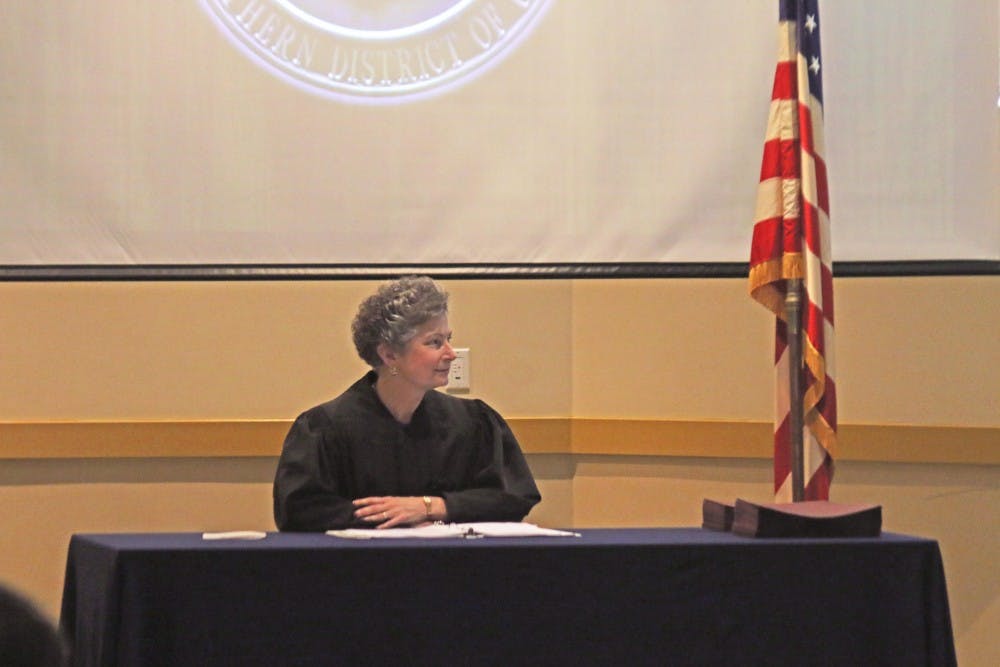On Friday, April 26, students gathered in 322 McGuffey Hall, which had been transformed to mimic a courtroom. A judge sat at the front wearing long robes, and someone rapped a gavel on a table to signal the beginning of the ceremony. Students gripped American flags as they prepared to take an oath of citizenship at this mock naturalization ceremony.
The ceremony was the culmination of an immigration project in History 112 (HST 112). HST 112 covers American History from 1877 to the present. Professor Andrew Offenburger has taught this course in the past, but this semester he decided to do it a little differently after attending his wife's naturalization ceremony in December 2018. She immigrated from Argentina in 2004 and eventually became a permanent resident after deciding to pursue citizenship.
"In that courtroom, when I witnessed the ceremony in December, I felt like I saw a part of the United States that I just could not get studying it in history books," Offenburger said. "And if I could give my students a little taste of what that is I felt at that ceremony, then the project would be worthwhile."
While Offenburger acknowledged that anti-immigrant rhetoric is prominent in the current political climate, he said this was not his reasoning for starting the project.
Talk of immigration trickled into a lot of the class' lectures, as it is a large part of American history. Offenburger also recognized the importance of people who did not immigrate to the U.S., like Native Americans, or African slaves, who did not come to the U.S. by choice.
As part of the immigration project, which was 10 percent of the final grade, students filled out immigration forms, which Offenburger replicated down to the font choice. He then either accepted or denied the students, and they went on to do an in-person interview with him.
The test included an oral exam with one of the graduate assistants of the course. Students were given 100 questions to learn about American history and politics -- the same questions immigrants learn -- and asked 10 of them at random during the exam. To pass, students had to answer six of them correctly.
Out of 94 total students in the class, 91 passed the test, and 84 attended the naturalization ceremony.
At the ceremony, Magistrate Judge Karen Litkovitz spoke about her experiences presiding over naturalization ceremonies, which she said is the best part of her job. A magistrate judge is appointed by district judges for an eight-year term and is responsible for federal criminal and civil cases.
"I believe that America prospers for many different reasons, one of which derives from the strength that we have from a diverse population," Litkovitz said. "We have young people, older citizens who come from different religions and cultural backgrounds, and they bring all that with them to help our country grow and develop as a nation."
After Litkovitz spoke, the ceremony itself began, which she presided over. Offenburger made an effort to replicate an actual naturalization process as closely as possible, including the design of the programs, the small flags he gave each student and the certificates they received at the end.
Offenburger asked some colleagues to speak in their native tongue about their process of becoming citizens. Juan Carlos Albarran, a professor in the Global and Intercultural Studies department, became a U.S. citizen in 2005.
Enjoy what you're reading?
Signup for our newsletter
He spoke in Spanish about this process and his experience immigrating from Cuba, with an English translation on the screen (the following is an English translation of Albarran's comment.)
"This was a gratifying experience for me, for it allowed me to enjoy the basic freedoms of citizenship like the right to vote," Albarran said. "My first experience with this great responsibility was when I voted for the first African-American president in the history of the United States in 2008."
Next, the students all stood up and introduced themselves, giving their name and the country they represented. Students chose their own countries; Offenburger encouraged them to choose a place meaningful to them, possibly one their own family had come from.
Students then took an oath of citizenship, said the pledge of allegiance and went to the front, one by one, to receive a certificate from Litkovitz.
"I think everyone should do this just to see what all immigrants go through," said first-year Julia Nunn, a HST 112 student. "If it was hard for me, and I've lived here my whole life, I can't imagine how hard it would be for people who are real immigrants and haven't grown up [reading] history books and all of that."
One of the students in the course, John Salukombo, went through the citizenship process last year after coming to America from the Democratic Republic of the Congo when he was 10. He said the project in class was similar to what he experienced last year.
"It's a good process for people to actually see what actual immigrants have to go through," Salukombo said.
Offenburger said he hopes this process made an impression on even just a few students and makes them more sympathetic to what people have to go through to become U.S. citizens.
"I don't care so much if they remember names and dates 10 years from now about American history, but if they remember a feeling they had ... that's what I go for," Offenburger said. "I always remember things more vividly when I feel it than if I just read about it or study it."
Offenburger said although he has not yet received feedback from students, he expects to continue this course in the future.
Additional reporting by Erin Glynn.




